Justice Denied: A Call for Action in Our City’s Housing Courts
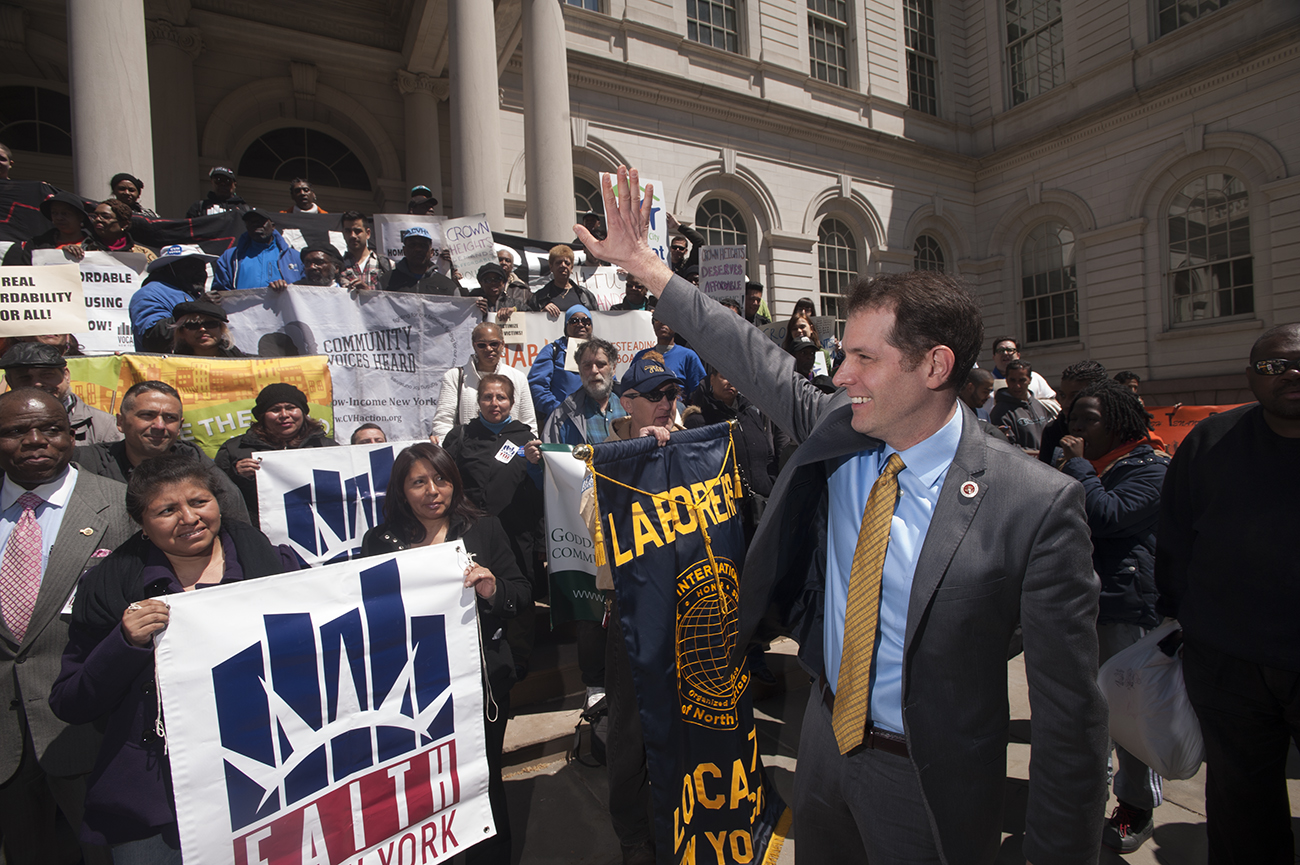
Council Member Mark Levine, co-author (William Alatriste)
If your only source of information on our legal system were Law & Order, you might believe that everyone going into a courtroom to face a potentially life-changing judicial decision would have the benefit of an attorney.
You would be wrong. The right to counsel applies only in criminal court. In civil court, only those with means have attorneys – and everyone else is left to fend for themselves.
This has clear implications for the fields of immigration, bankruptcy and family law. But it is in housing court (the division of civil court dedicated to ruling on disputes between landlords and tenants) where the impact is breathtaking, with sweeping consequences for New York City.
Fewer than 10 percent of tenants in housing court in the five boroughs have the benefit of legal counsel. In contrast, upwards of 90 percent of landlords citywide have representation. This makes housing court in New York City a dramatically uneven playing field.
New York's housing court system is notoriously byzantine, and is complicated to navigate even for attorneys. Tenants forced to represent themselves on this terrain can have difficulty grappling with even basic procedural matters like filing the necessary paperwork to secure a court date. Failure to do so results in a default judgement in favor of the landlord.
The imbalance in housing court carries a heavy toll for tenants: in 2013 there were nearly 30,000 families evicted from their homes in New York City. This figure is steadily rising, up more than 20 percent in the past decade. Two-thirds of evictees have annual incomes of $25,000 or less. Two-thirds live with children under 18 years of age.
For low-income tenants, the consequences of evictions are devastating. Evictions contribute to our record homeless population and the city's rapid loss of affordable housing. Thirty-seven percent of those admitted to our shelter system are coming directly off an eviction, and the vast majority of these individuals had no attorney during their housing court proceedings.
The majority of evictees live in rent-regulated apartments. Once these homes are vacated, landlords can easily exploit legal loopholes to permanently move the units to market-rate rent for future tenants.
Landlords are all too aware of the uneven nature of housing court. The most unscrupulous building owners regularly initiate legal proceedings based on shaky cases. They bank on the fact that few tenants will be able to afford an attorney and many are intimidated into leaving their apartments rather than face a trial.
Even tenants who win their cases don't necessarily come away unscathed. A small industry of tenant screening companies maintains a "black list" of individuals whose names appear in housing court proceedings. Many landlords in New York City and nationally buy these lists and will refuse to rent to tenants who have had cases brought against them, regardless of the final decision of the housing court judge.
Most elected leaders in New York City support ending this clear injustice. The obvious solution is to provide attorneys for tenants in housing court. But funding concerns have prevented anything more than tiny pilot programs from taking root.
There are, however, compelling economic arguments for implementing such programs. Each bed in our homeless shelters costs $36,000 per year. Developing a single unit of affordable housing costs over $250,000. Yet the price of legal representation in housing court is a comparative pittance, estimated at $1,600 to $3,200 per case.
We are collaborating with our ally and colleague, Councilmember Vanessa Gibson, to address this problem. The Levine-Gibson bill, Intro 214, calls on the City to provide all low-income tenants with attorneys in housing court. A majority of the City Council already co-sponsors this bill.
We are optimistic the momentum for dramatic action on behalf of low-income tenants in housing court will continue to mount. After all, viewers of Law & Order know that the little guy can indeed beat long odds and win the case. Especially when they have a good attorney.
***
Mark Levine is the New York City Council Member for the 7th District in West Harlem and Jaron Benjamin is the Executive Director of the Metropolitan Council on Housing.
Expanding Opportunity for Civic Engagement to the Next Generation
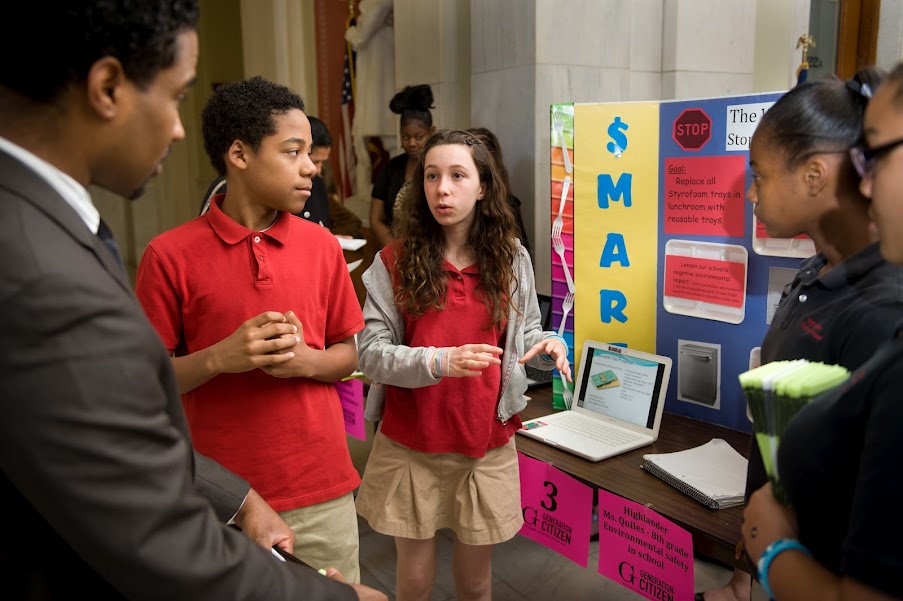
(Students present at a Generation Citizen Civics Day)
One of the best parts about living in New York City is that even though we reside in the biggest city in the country, individual citizens can play a vital role in deciding community issues. An example of this citizen engagement is our 59 community boards, comprised of local civic leaders, which serve to empower residents to address zoning issues, assess the needs of their communities, and offer substantive policy recommendations to their elected representatives.
But currently, community boards exclude one of the most important demographics in our city - young people. Only residents 18 years and older are eligible to be appointed to these boards. The state Legislature is considering bills, sponsored by Senator Andrew Lanza (S04142) and Assemblywoman Nily Rozic (A02448), which would grant up to two 16- and 17-year-olds the opportunity to formally serve on each board. This would ensure that young peoples' voices are heard, while simultaneously demonstrating New York City's support to furthering youth civic engagement. Councilmembers Ben Kallos, Mark Levine, and Ritchie Torres have sponsored a City Council resolution of support, and a public hearing will be held at City Hall on June 9th to discuss the proposal.
The legislation would not mandate the inclusion of 16- and 17-year-olds, but by providing the option, the bill would allow boards to diversify their composition, benefit from diverse input and perspective, and demonstrate their community's value of and investment in their future leaders.
Although the legislation must pass at the state level, city elected officials are doing their part in advocating for the change. Manhattan Borough President Gale Brewer has championed this bill from its inception, and three of her fellow Borough Presidents have pledged their support. It is clear that almost every elected official in New York City endorses this legislation - Albany must act accordingly.
While the bill seems to have overwhelming support throughout New York City and the state, some opponents do argue that young people are not responsible enough for this commitment. It is important to note, however, that this bill does not change the qualifications and high expectations for membership. We should continue to hold our community board members to high standards while also recognizing that some young people are eager for and ready to take on these responsibilities, and that this experience would help them grow as leaders.
New York City Comptroller Scott Stringer served on his community board at the age of 16. He proved ready for this challenge, and this early political training prepared him for an esteemed, long career in public service. Young people make and sustain commitments all the time: sports teams, clubs, jobs, and schoolwork. They can serve on these boards, and do so effectively.
Others argue that young people are not informed enough to weigh in on necessary discussions involving land use and zoning. But community boards must educate all members on these issues, including adults. Young people would be able to provide a different perspective on these topics that might not otherwise be represented.
Finally, opponents say that there is already poor youth (18-21-year-old) participation on boards, meaning that there is no reason to expand the opportunity to others. But the comparison is not quite fair. Many 18- to 21-year-olds are in college, or living on their own for the first time. Sixteen and seventeen-year-olds are, for the most part, much more stable. At the end of their high school years, they have adjusted to managing school and extracurriculars, and they often still have the support and structure of family life to ground them. We should be taking advantage of this life cycle to identify and develop young leaders while they are still firmly part of their communities through school, faith, and neighborhood bonds.
This opportunity may also serve to reinvigorate in-school discussions about civic responsibility and political participation. Knowing that students are eligible for official community board service could encourage teachers to educate students about local government structures and activities, proactively building knowledge of and respect for these institutions among our future civic leaders.
Our communities deserve the best advocates we have, and those advocates might just be carrying backpacks. Let's not hold that against them. The State Senate and State Assembly should pass the Lanza/Rozic bill and send it to Governor Cuomo for his signature this session.
***
Sarah Andes is the New York Site Director of Generation Citizen.
***
@GothamGazette
Submit an op-ed idea or draft to Gotham Gazette executive editor Ben Max: This email address is being protected from spambots. You need JavaScript enabled to view it.
Let's Be Cautious With Local Minimum Wage
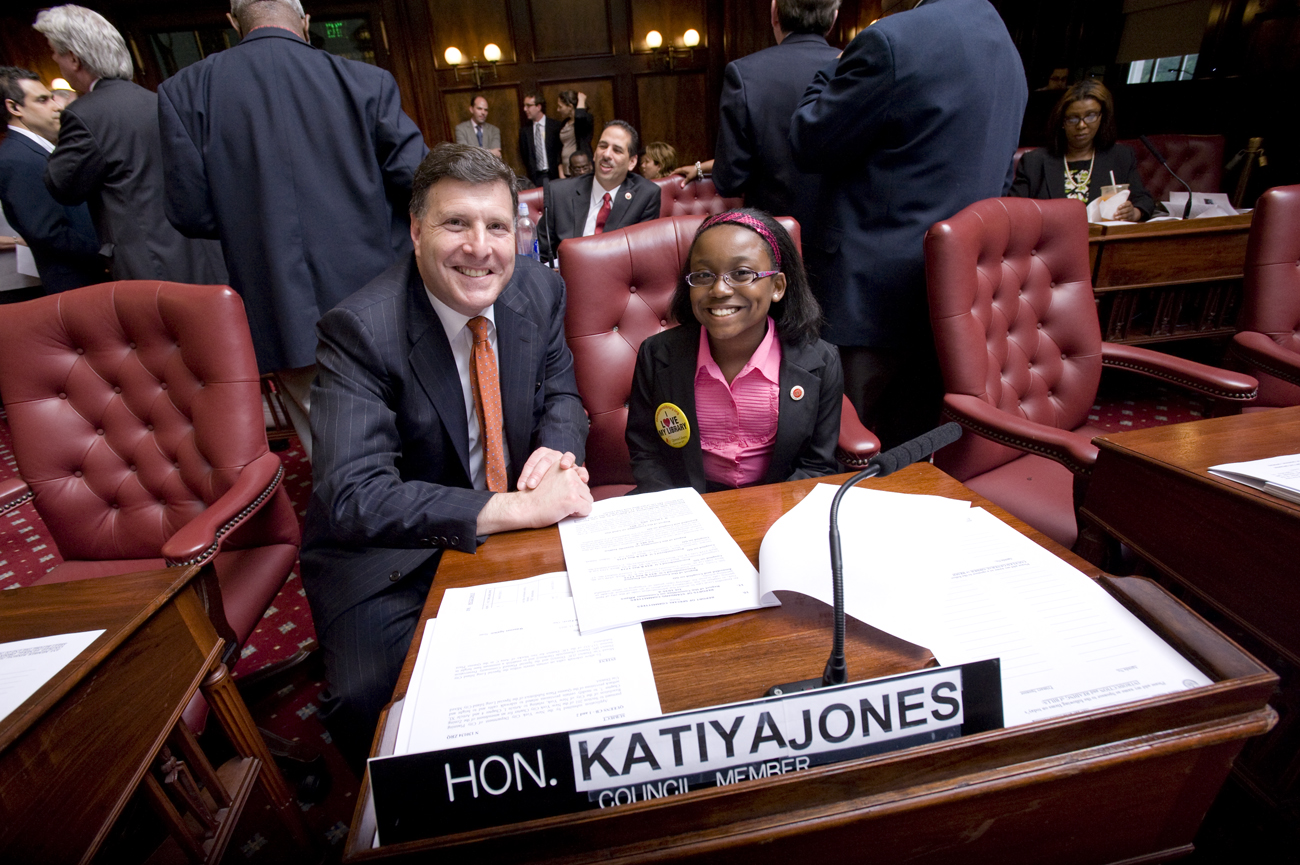
Council Member Mark Weprin, the author, and his guest council member for a day (William Alatriste)
During his State of the Union address, President Obama vowed to work with Congress on legislation that would increase the Federal minimum hourly wage from $7.25 to $10.10. A week later, Mayor de Blasio told reporters that he supports legislation that would raise the State's minimum wage from $8 to $10.10 next year. That same bill, now reported to be backed by Governor Cuomo, would also allow local municipalities to set their own rates for the minimum wage.
I agree with the president, the governor and the mayor that the minimum wage needs to be increased. Working families all across the country are struggling to make ends meet and putting more money in their pockets is undoubtedly a step in the right direction. It is outrageous that here, in New York State, retail employees, fast food workers and other minimum wage earners are expected to provide for their families with an $8 hourly wage. The cost of living continues to rise and today's minimum wage is clearly failing to keep up.
At the same time, I have serious concerns about permitting local municipalities to set their own minimum wages. While the concept sounds great in theory, in practice it has the potential to hurt local small businesses and deter businesspeople from opening up new businesses in certain areas of the City.
The Council district I represent encompasses a number of neighborhoods on the Queens County/Nassau County border; the entire district is within a 10-minute drive of Nassau County. Many of my constituents even live within walking distance of the city line. If New York City sets a higher minimum wage, entrepreneurs considering opening businesses in Eastern Queens will have a financial disincentive. Why open a new business in a Queens neighborhood like Floral Park, Glen Oaks, New Hyde Park, or Little Neck when you can simply site the business a few blocks away in Nassau County, where the minimum wage is lower? A similar problem presents itself in neighborhoods across the Northern Bronx, which borders Westchester County, and Staten Island, which is close to New Jersey.
Businesses that are already established in areas on the outskirts of the City will also suffer if the proposed legislation is approved. To compensate for the financial losses caused by minimum wage hikes, business owners will need to increase the prices of their products. Doing so could have a devastating impact on many of the local establishments that operate on thin margins to begin with, as consumers will have cheaper alternatives nearby. The consequences may even be severe enough to put some places out of business.
Raising the minimum wage is a great idea, but we should implement the change for the entire country or at least the whole State of New York. Setting different wages in neighboring cities and towns is a well-intentioned concept that can backfire big time.
***
Mark Weprin is the New York City Council Member for the 23rd council district, in Queens.
21st Century Learning Includes BYOT
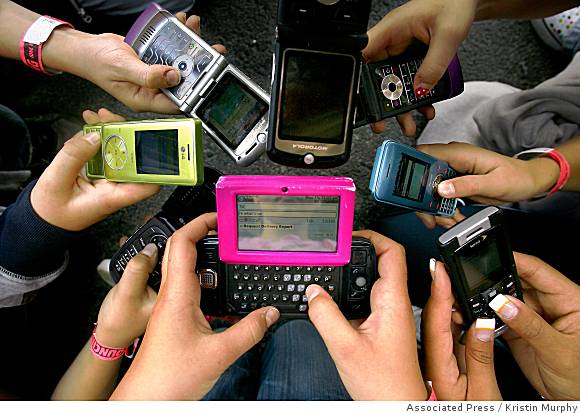
Kids are doing it in Cincinnati and Tacoma. They're doing it in Louisville, Ocean Springs, Dallas, West Fargo, Atlanta, Brentwood and New Smyrna Beach. It's time we worked together for New York City youth to do it too.
I'm talking about students in public schools with programs called Bring Your Own Technology, or BYOT, which support and encourage the use of personal devices like smartphones, tablets or e-readers in classrooms.
Rather than confiscating phones upon entry to the building, teachers in BYOT schools are integrating mobile apps and tools into their lessons. Students use Google Drive to collaborate on projects, answer pop quizzes, participate in class discussions, snap photos of assignments and classroom presentations and much more. Meanwhile, teachers are using their own tools to help them create data visualizations showing whether students have grasped a concept, to track class participation and to communicate with students learning English as a second language.
But, in New York City public schools, mobile devices have been banned since the 2005-2006 school year.
According to a 2013 study by the Pew Research Center and the Berkman Center for Internet & Society, 37% of all teens have smartphones, compared to 45% of all adults. Moreover, teens living in households with annual incomes under $30,000 are only 4% less likely than their wealthier peers to own a smartphone. Given these findings, it makes sense for schools with tight budgets to have students use the technology they already own, rather than invest in computers and other digital labs.
Of course, there are hurdles we will need to work to overcome: so many online devices can stress school data networks, forcing many teachers to allow students to access the Internet using their own data provider network, which allows them to get around firewalls blocking social media and inappropriate websites. Not every student in a class uses the same device, and it's important for teachers to receive training before implementing a BYOT program.
With The LAMP, media literacy program facilitators travel to schools and communities throughout New York City, typically transporting laptops, cameras, microphones and other equipment, enabling us to bring 21st-century learning opportunities to young people and adults who otherwise use technology primarily for entertainment. We've worked in schools of five hundred students, all sharing one laptop cart and one media librarian. We've been in school technology labs stocked with computers that rarely get used, often because they're horribly out-of-date or because few people have any training on how to use them to support teaching. Meanwhile, most of the students have their own technology, which they already know how to operate, and which are typically not more than a couple of years old.
Educators and administrators nationwide are acting on what they see as the inevitability of BYOT in schools. As Lenny Schad, chief technology information officer at the Houston Independent School District, told the New York Times in March, 2013 after implementing a BYOT program in Katy, Texas, "My message: It shouldn't be 'if' we do it, it should be 'when' we do it...On a smartphone, there are no limitations. This is the world they live in and we're bringing it into the classroom."
When we confiscate students' smartphones, we are sending them a firm message that technology devices are toys. So it can be no surprise that young people treat them as such, particularly if they're not fortunate enough to be in schools that issue laptops and tablets to each student, or where each student spends school time every day on a computer connected to the Internet. If we're not showing them the endless possibilities of how they can learn and explore with technology, they're being left behind as millions of other young people come to understand that technological devices are actually tools to connect them with an endless array of resources to support learning, civic engagement and creativity, often available at little or no cost.
Successful BYOT programs are not implemented overnight, but as so many wise teachers told me when I was young, anything easy probably isn't worth doing. Models for BYOT programs are out there and working in school environments that are suburban and urban, advantaged and disadvantaged. It's time for all of us – program providers, students, educators, parents, the Mayor's office and the DOE - to work together to relinquish the ban on smartphones in classrooms, and at minimum launch BYOT pilot programs in our public schools to help New York City students gain the skills they need to get jobs in the multi-billion dollar tech and media industries our city is working so hard to build up.
***
Emily Long is the Director of Communications and Development at The LAMP. Find her on Twitter using @emlong, or follow The LAMP at @thelampnyc.
***
Gotham Gazette's executive editor, Ben Max, is a member of The LAMP's young executive board. Opinions of neither Ben nor Gotham Gazette are represented in this article.
Principal to Chancellor: Take the Lead on School Discipline

The author, Principal Brady Smith
"Our schools are learning places. They're not suspension places," said Chancellor Fariña to a room full of principals this past Saturday. Could this mean real change in the way we view students in the classroom?
In Los Angeles schools, they call it "willful defiance"; elsewhere, "insubordination." In New York City, "B21" or "defying or disobeying lawful authority" is the second most common reason students are suspended in school each day (based on the data we have available).
Last year in New York City schools, black students, who comprise less than a third of the student population, served more than half of the suspensions citywide. Students with disabilities, making up twelve percent of the student body, served a whopping thirty percent of principal and superintendent suspensions. Are our black students or students with special needs more disruptive, or more dangerous, than their white peers? No.
Mayor de Blasio has made a public commitment to tackle these disparities and I am confident that in this administration, positive school discipline is a priority. I was thrilled to hear the Chancellor say that the Department of Education is "looking seriously at a revised (Discipline) Code". By focusing on those most impacted, students of color and students with disabilities, we can move on making progressive reforms in school discipline in NYC. The removal of suspension as an option for B21 in the soon-to-be-released 2014-2015 Discipline Code will be a great step in the right direction for all NYC students.
An educator for 24 years and principal in New York City public schools for 7 years, I have seen my share of 'defying authority.' One of my former students, who I'll call Gerald, regularly defied school staff and safety officers. He'd get angry and walk out of classrooms, he'd tell off adults who tried to stop him, and he rejected our initial attempts to counsel him. Suspending him may have temporarily put a stop to classroom disruptions, but it would not have given him the tools to manage his anger and strategies to move past his frustration.
Instead we involved him in a Fairness Committee where fellow students and adults described how his behavior affected them. And together with his mother, we collaboratively devised a behavior contract that included supports he might need from adults at school, supports like the opportunity to take a time out if he felt his frustration getting out of hand. His advisor checked in with him regularly and celebrated with him when he managed his anger. He struggled to make the change, and had some bad days, but ultimately he stayed in school, developed skills in anger management, and mastered his academic content. My experience in schools, with many, many Geralds, has taught me that there are more effective ways to shift defiant behavior than suspension.
The current discipline code allows principal's suspension of up to five days as an option for students who defy authority. Although the racial breakdown of the data for New York City's B21 is redacted, it's not a surprise that this infraction is a hyper-racialized one elsewhere in the country. Students of color and students with IEPs are disproportionately impacted.
In Los Angeles, suspension for their version of defying authority has been removed as an option district-wide. The principal of L.A.'s Garfield High School took suspensions off the table altogether last year, noting, "I can't teach a kid if he's not in school." Far from descending into chaos, the school has transformed.
Policy change has to happen from the top, and must be coupled with school-based training and resources. Removing suspension as an option for B21, providing educators with professional development in restorative discipline approaches, and requiring that positive interventions are implemented before suspension can transform our schools. We are days away from the release of the draft Discipline Code. The moment is now; this is the right administration to position New York City as a leader in ending discriminatory discipline.
***
Brady Smith
Principal Co-Director, The James Baldwin School
VA Scandal Demands Bold and Decisive Action

Coast Guardsmen, 2013 NYC Veterans Day Parade (Petty Officer 2nd Class LaNola Stone)
Last month, reports surfaced that a Phoenix-based Department of Veterans Affairs (VA) health care facility maintained two separate lists of patients, one of which doomed nearly 1,600 sick veterans to suffer serious illness without treatment and led to the preventable death of 40 others.
Since the Phoenix scandal emerged, other VA hospitals across the country are warning of similar instances and schemes to cover up excessive waiting times for care. A Congressional hearing earlier this month revealed a 2010 VA internal memo from a high-ranking official addressing "inappropriate scheduling practices" to cover up delays. The practice, referred to as "gaming strategies," should have ended a long time ago, but evidently still exists.
According to the VA Inspector General (IG), 26 VA healthcare facilities nationwide are now under investigation for serious allegations of fraud, malfeasance, and mismanagement. Equally disturbing, some executives from these troubled facilities received performance bonuses upwards of five figures in 2013.
Over this past Memorial Day Weekend, I heard from countless veterans their outrage and disgust with this scandal and the fundamental lack of accountability and widespread mismanagement at the VA. Our veterans deserve the facts and there must be some degree of answerability and consequence for those officials who presided over these heinous acts.
This is why I recently introduced a resolution (Res 0201-2014) to the City Council in support of The Department of Veterans Affairs Management Accountability Act of 2014. This Act would enhance accountability by providing the VA Secretary the authority to immediately remove Senior Executive Service (SES) employees for performance. Current employment protections afforded to SES employees make it extraordinarily difficult to remove them. This bill eliminates the appeals process to allow for immediate disciplinary action that will ultimately aid in reducing the VA's backlog, improve access to care, and bolster other services.
Going forward, the VA needs to act immediately to ensure that veterans who may have been affected by delays in care secure the medical attention they need. The Obama administration announced this weekend that more veterans will be allowed to get health care outside of VA facilities, but this policy should be broadened, extended, and potentially made permanent to avoid any further delays.
Congress should also move quickly to enact legislation that would provide veterans easier access to care. Earlier this year, Senator Bernie Sanders introduced sweeping legislation that addressed the disability backlog, healthcare, education, and other core issues. Regrettably, this bill was defeated. However, I implore our federal representatives to re-work and re-introduce this package with measures that enhance accountability and streamline the process for veterans to receive the health care services they need and are rightfully entitled to.
Our veterans deserve answers and we need leadership from Congress and the President. Our veterans fought our wars and answered the call to protect our freedoms time and time again. Now it is our duty to fight for them.
***
Eric Ulrich is a Council Member from Queens and Chairman of the Council's Committee on Veterans.
A Commitment to Affordable Housing
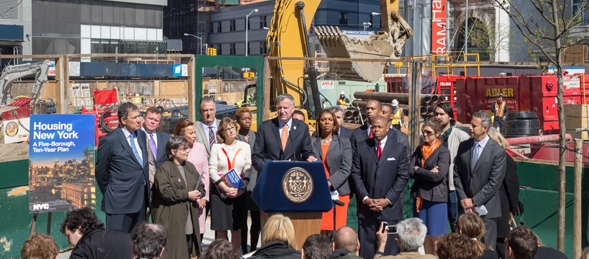
Mayor de Blasio announces his housing plan (nyc.gov)
Over the past several weeks, those of us committed to meeting the housing needs of all New Yorkers have witnessed real progress, giving us great hope for the future of affordable housing in our city and state. Highlighted by the announcement of a comprehensive housing plan for New York City, along with a sound capital budget, we have learned that we have a Mayor and housing leaders who are true visionaries for dramatically growing New York City's affordable housing stock.
This was particularly evident when last week the de Blasio administration, as the old saying goes, put their money where their mouth is. By announcing $1.2 billion in additional capital funds as well as critical increases for HPD staff, the Mayor has demonstrated a significant and wise investment to immediately allow for the construction and preservation of units across the five boroughs.
For the Mayor's plan to succeed, however, it will take more than just the work of government, which is why, as the state's largest organization of affordable housing professionals, we have been called to action. Speaking at our 15th annual NYSAFAH housing conference earlier this month, Mayor de Blasio addressed the more than 1,400 attendees and outlined his guiding principles towards reaching 200,000 units over the next decade, including smart rezoning, eliminating regulatory hurdles, and streamlining permitting – all worthy objectives.
As he concluded, the Mayor made his case for why, in order to meet the plan's ambitious benchmarks – 8,000 units of new housing per year, for instance – all of us committed to affordable housing must work faster, more creatively, more efficiently, and, most importantly, must work together. This includes, among other priorities, placing an emphasis on bringing new construction to economically distressed neighborhoods, as well as preserving existing housing in order to ensure these buildings can remain affordable over time.
A true public-private sector partnership is the only way to ensure we are using every tool available to solve New York's housing crisis, and our organization is honored that the Mayor has asked for our collaboration in this effort. Our members stand at the ready. With decades of experience investing in New York's communities, we understand that the real goal of affordable housing is to ensure that every New Yorker has an opportunity to succeed. Affordable housing revitalizes entire neighborhoods, it creates jobs, and it allows our economy to grow.
This will not be an easy task. But as the Mayor said in his address: "We don't take on small and easy plans. We challenge ourselves on purpose." We believe this is the right approach – one that leaves little doubt that the future of affordable housing in New York City is bright. With strong leadership from government and a community of private sector professionals demonstrating their shared commitment to this cause, we are confident that we will achieve the goals for the coming decade.
To those within affordable housing industry who have not yet joined our efforts – whether developers, financiers, or others – we urge you to become a part of this growing community. Together, we can achieve great things, enabling future generations to experience a city and state that is affordable for all.
***
Jolie Milstein is the President & CEO of the New York State Association for Affordable Housing, a trade organization representing more than 300 affordable housing professionals statewide. For more information on NYSAFAH visit www.nysafah.org
The Case Against Solitary

With about one percent of our adult population behind bars, far more per capita than any other country, the United States also leads the world in the use of solitary confinement inside our prisons and jails. Inmates in solitary are typically locked in cells about the size of a parking space for 23 hours a day, with no human interaction and no regular access to educational or vocational training, psychological counseling, addiction treatment, or other rehabilitative programs. While overwhelming empirical evidence indicates that imposed social seclusion can lead to severe and often-irreparable psychological harms, extreme isolation punishments unfortunately remain a popular and widely accepted means of enforcing prison rules.
Despite recent reforms, solitary confinement punishments are more prevalent in New York than in any other state, with two prison facilities entirely dedicated to housing inmates in seclusion cells. Each year, approximately 4,500 inmates across the state are subjected to crushing isolation, often for months or years on end. The situation in New York City's jail system is especially dire. A September 2013 study prepared at the request of the City's Board of Correction noted that 7.5% of all City inmates are held in solitary at any given time.
The prevalence of solitary confinement as a disciplinary method of first resort flies in the face of what the Supreme Court once described as "the evolving standards of decency that mark the progress of a maturing society." Complete social seclusion and sensory deprivation have long been used as methods of psychologically dismantling captives for interrogation purposes. In recalling his experiences as a prisoner of war in Vietnam, Senator John McCain has described how solitary "crushes your spirit and weakens your resistance more effectively than any other form of mistreatment." The contemporary use of extreme seclusion as a jailhouse punishment is practically indistinguishable from its use as a wartime torture device, and the resulting mental health effects often last far beyond inmates' time in prison, with obvious negative implications for criminal recidivism.
Disciplinary actions and administrative decisions made behind prison walls are largely impervious to monitoring or supervision from the outside world, and prisoners who face solitary punishments generally have no recourse aside from a lengthy petition process which can last beyond the time of their initial prison sentence. Inmates have no right to legal assistance during disciplinary proceedings and must represent themselves against accusations brought by prison officials, many of whom work alongside the hearing officers who determine the inmates' guilt and set their punishment.
The use of solitary confinement for any reason, and for any length of time, is a fundamental human rights concern, and our Constitution requires that individuals' liberty interests should not be deprived without due process of law. While the Supreme Court has so far refused to provide incarcerated people with a right to legal assistance during disciplinary hearings, legislators and executives at the state and federal level should implement measures to provide counsel for inmates who face potential isolation punishments. To stem the abusive and reflexive use of solitary confinement, prisoners in disciplinary proceedings should be given competent legal assistance and a fair hearing before an independent hearing officer. In addition, those who are sentenced to a period of solitary confinement should be afforded regular access to legal counsel throughout their time in isolation.
The financial cost of providing competent representation in these situations would likely be offset by even a slight reduction in the use of solitary confinement. During a recent Congressional subcommittee hearing, Senator Dick Durbin of Illinois noted that it costs the federal government nearly three times as much to keep an inmate in an isolation cell than in the general prison population. Indeed, as Mississippi, Illinois and several other states have moved to reduce their use of solitary confinement in recent years they have realized tremendous cost savings in addition to decreased levels of prison violence.
In February, the de Blasio administration agreed to settle a lawsuit brought by the NYCLU and to limit the use of solitary confinement against teenagers while also placing caps on the length of isolation punishments for certain offenses, and Joseph Ponte, New York City's new DOC Commissioner, is known as a reformer who cut the rate of solitary punishments in Maine's prisons by two-thirds. New York State prison officials have also made efforts in recent years to reduce the prevalence of solitary confinement by prohibiting its use against mentally ill inmates. While these developments mark some degree of progress in addressing the serious problems caused by the pervasive use of solitary confinement, there are still thousands of people across the state at any given time who have been sent to "the hole" without adequate representation or an objective fact-finding process.
As a society, our standards of decency may continue to evolve, but every day in our prisons and jails thousands of people are subjected to debilitating psychological harms for want of effective advocacy and outside intervention. Human rights and the need for due process do not end at the prison gates, and as a mature society we should at the very least provide counsel and assistance to those who face what may be our last legal form of torture.
***
by Lucas Anderson
Contact: This email address is being protected from spambots. You need JavaScript enabled to view it. & @CriminalNYLaw
What's So 'Progressive' About 1000 New Police
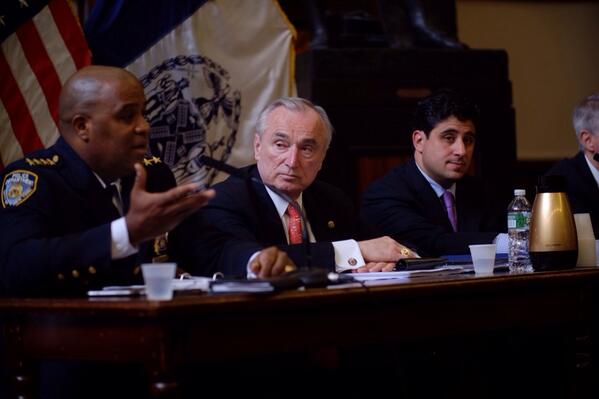
Representatives from the NYPD testify at the City Council (William Alatriste)
The first showdown between Mayor Bill de Blasio and City Council Speaker Melissa Mark-Viverito, erstwhile progressive partners, has come over the police. In his budget last week, de Blasio shot down Mark-Viverito's call for 1000 new officers, but the speaker says she's sticking to her demand.
While some have criticized de Blasio for bringing back William Bratton as police commissioner because of his past association with Mayor Rudolph Giuliani and a variety of punitive policing tactics targeting youth, homeless people, and sex workers, the mayor held the line on the police budget. He has refused to add more officers despite extensive pressure from the police unions.
Mark-Vivertio, however, in her first major budgetary stand is demanding that the Mayor add 1,000 new officers. The $97 million price tag makes up 40% of the new spending the Council is proposing.
On Monday, the Black, Latino, and Asian Caucus (BLAC) held a press conference to reinforce the speaker's call for hiring more police. Council members pointed to recent upticks in crime in mostly minority communities as the primary reason for needing more police on the streets. But, will more police on the streets help reduce violent crime?
Several council members feel that local police precincts are stretched too thin, forcing them to rely on excessive and costly overtime. The speaker argues that some of the new expense of hiring more police will be recouped by reducing overtime costs—a laudable goal. However, much of the overtime accrued by police is not directly tied to staffing levels. Officers routinely rack up large amounts of overtime when they make arrests near the ends of their shifts. Standard procedure calls for the arresting officer to follow through on the processing of the arrest to ensure continuity of evidence and paperwork. Another big chunk of overtime comes from detectives and specialized units who are sometimes put on assignments that take up more than a standard shift in order to maintain the integrity of an investigation.
Reducing these forms of overtime would require a change in police procedures, not increased personnel. The one area where staffing increases might reduce overtime costs is in counterterrorism, but adding more cops there would do nothing to beef up local precincts. At a city council hearing on Tuesday Bratton said he intends to use the equivalent of 320 officers' worth of overtime to address increased crime in public housing, but according to the NYPD's own analysis most of this uptick is in domestic violence, which is largely impervious to increased policing.
During the Bloomberg years the number of police fell by 15%. But, over the last 20 years major crimes such as homicide and robbery are down 80% or more as are auto theft and larceny. Despite constant claims by many police leaders and politicians, the evidence is clear that these dramatic drops in crime are not primarily the result of policing. While there were significant changes in how policing was conducted in New York in the mid 1990s, the crime drop started well before that.
More importantly, the crime drop is an international phenomenon affecting cities and countries that made no changes in the way they conducted policing, added no new officers, and in some case pursued strategies antithetical to those used in New York. Berkeley law professor Franklin Zimring, in one of the most rigorous examinations of the issue, found that at best 20% of the reductions in robbery and burglary might be because of policing changes specific to New York, and even this was based on a process of eliminating other explanations, rather than the identification of clear positive evidence. In addition, there are numerous studies that show that there is no causal relation between increasing the number of police and reducing crime. During the high crime periods of the 1980's and 90's New York had one of the highest concentrations of police per capita of anywhere in the country, but it seemed to have no effect on explosive outbursts of crime.
Throughout the city and around the country there is a growing awareness that there are ways to produce public safety that don't rely on police, courts, and prisons. New York has a string of community based organizations, such as SOS Crown Heights, Man Up!, and the South Jamaica Cure Violence Program, that are working with young people in high crime areas to teach them alternative conflict resolution methods, help them overcome problems at home, and mentor them for success in school, work, and life.
The City Council has been an important supporter of these groups, using some of its discretionary money to fund them through the Council's Anti-Gun Violence Task Force co-chaired by Jumaane Williams from Brooklyn and Fernando Cabrera of the Bronx. Unlike Mayor Bloomberg, Mayor de Blasio has put some resources into the baseline budget for these groups. The Task Force, however, asked for more and is trying to find the money. The difference: about $6 million.
One of the things that's been learned by these groups and many researchers is that increased and aggressive policing actually makes their work harder. The constant harassment and criminalization of young people pulls them out of school, disrupts their home life, reduces their self-esteem, immerses them in a culture of violence, gangs, and professional criminality, and inhibits their future job prospects.
The main culprit in this dynamic has been the aggressive pursuit of the War on Drugs. The NYPD continues to make tens of thousands of low-level drug arrests every year. After a short-lived drop off during the mayoral transition, marijuana arrest rates have again spiked to their previous levels of 30,000 a year. And these arrests are highly concentrated in communities of color. According to an analysis by Queens College Sociologist Harry Levine, in the first 3 months of 2014, in predominantly white Park Slope, police made 7 marijuana possession arrests and in Carroll Gardens and Red Hook, they made 12. At the same time police made 111 of these arrests in Bedford Stuyvesant, 130 in Crown Heights and 438 in East New York, all neighborhoods that are mostly black and Latino.
Commissioner Bratton has made it clear that he opposes decriminalization of marijuana (despite the fact that private possession is already decriminalized) and will continue to aggressively enforce the drug laws. More police on the streets invariably means more low level arrest, more criminalization of young people, and more of a siege mentality in high crime areas. As Bratton pointed out in his first stint as Commissioner, police are not trained to be social workers, they are trained to enforce the law through arrests.
It is ironic that the members of the BLAC, who represent mostly poor minority neighborhoods, are prioritizing increased spending on new police while decrying the lack of resources for community-based anti-violence initiatives. Politicians in high crime communities like those represented by BLAC members need to quit looking to the police to solve their communities' problems. We cannot arrest our way out of gangs, drug abuse, and or even violent crime. It's time to move beyond the failed policy of throwing more cops at the crime problem. To really produce long-term safety we need to support truly progressive programs that invest in the lives of young people in high crime areas, not in more police.
***
Alex S. Vitale is Associate Professor of Sociology at Brooklyn College and author of City of Disorder: How the Quality of Life Campaign Transformed New York Politics
Contact: This email address is being protected from spambots. You need JavaScript enabled to view it. & @avitale
The Aging Tsunami: Building an Age Equality Platform in New York City
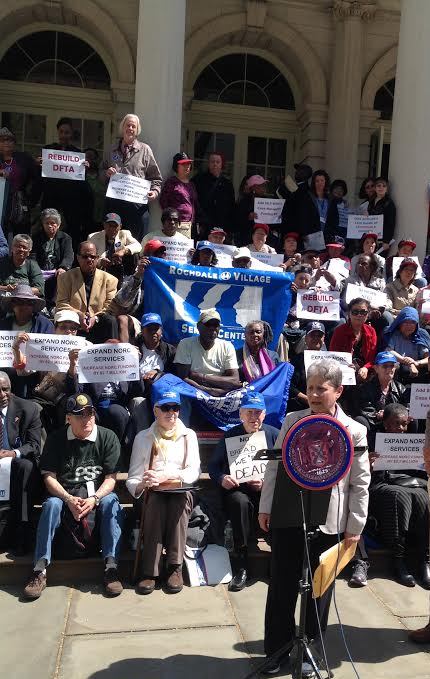
Bobbie Sackman, the author, speaks at a press conference at City Hall (Emmanuel Yusuf)
Mayor de Blasio's new housing plan recognizes that New York City is in the middle of an "Aging Tsunami" and pays special attention to senior housing. From 2000-2030, the city's age 60+ population will increase by 47% to 1.84 million, or 20% of the population. According to the City's measure, more than 20% of older New Yorkers live in poverty. Average annual Social Security payments of only $14,700 leave thousands struggling financially. Single elderly households, on average, pay 58% of their income on rent, with little left to afford food or medicine. There is a compelling need for affordable senior housing.
The Mayor's plan offers an increase in supply of senior housing (including on NYCHA sites), supports higher SCRIE income limits and better outreach, and champions Naturally Occurring Retirement Communities, among other initiatives. This is smart and cost-effective planning but what really distinguishes his attention to senior housing is compassion and dignity. Mayor de Blasio understands that older adults are the backbone of families and communities.
All that being said, Mayor de Blasio's 200,000-unit affordable housing plan can be a game-changer for New York's elderly with three add-ons:
1) The City must at least double production of senior housing. The new housing plan does not specify production targets for senior housing and fewer than 10,000 senior units were developed and preserved over the last 10 years, while our population is aging and demand is growing rapidly. In addition to increasing production at HPD, the City should target 1 in 5 guaranteed inclusionary units for senior housing so that we can start to prepare for a population of 1 in 5 seniors that is expected by 2030.
2) The City must adopt a new model for senior housing which includes service coordination. Cost savings and improved outcomes can be achieved by congregate senior housing with an on-site social worker to connect low-income seniors with appropriate services and supports as their needs evolve.
3) City Hall must support SCRIE reforms that will reduce unmanageable and extreme rent burdens. Protecting seniors on fixed incomes from rent increases is essential, but for SCRIE beneficiaries who already pay more than half of income on rent, they need rent relief to age in place with dignity.
After seven years of relentless cuts, $55 million from the Department for the Aging (DFTA) funded community-based services, the City would be wise to invest in rebuilding services and enhancing those that are inadequately funded. A robust community-based service network along with a comprehensive affordable housing plan will go a long way to allowing older adults to remain actively engaged in their communities. Family caregivers, including many women in the workforce, need supportive services for their parents or loved ones in order to remain working or be promoted. Access to affordable elder care is the workforce issue of the 21st century.
CSCS' "Age Equality" budget agenda, totaling $25.4 million, includes core services that are substantially underfunded – increased funding for senior center and home-delivered meals so they meet the City's own nutritional requirements (meals currently meet the lower federal requirements); expanded elder abuse victim services to better address this hidden crisis; reducing case management for frail, homebound elders to relieve case managers with caseloads of 80 and over 1700 seniors on waiting lists; adult day care programs for people with Alzheimer's and respite for family caregivers; provision of a take away weekend meal from senior centers; NORC funding allowing seniors to remain home; and rental funds for financially strapped senior centers.
And, especially important in New York City is building capacity to serve an increasingly diverse older adult population is key to allowing older adults access to culturally competent services.
Challenges of growing old in NYC include issues and values progressives are concerned about: access to nutritional food and hunger, poverty and income inequality, domestic violence including elder abuse, affordable housing, support for families, support for immigrants, retaining and building strong communities and more. Including all New Yorkers across the lifespan in this great progressive movement is "age equality".
Impactful additions to the City's new housing plan combined with a robust community-based network of aging services will allow older adults to age with dignity in their homes. By adopting the Age Equality agenda, Mayor de Blasio will be laying the foundation to make New York a more affordable and livable city for all ages.
***
Bobbie Sackman is Director of Public Policy, Council of Senior Centers and Services
Contact: This email address is being protected from spambots. You need JavaScript enabled to view it.




